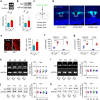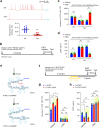Prenatal stress modulates HPA axis homeostasis of offspring through dentate TERT independently of glucocorticoids receptor
- PMID: 36481932
- PMCID: PMC10005958
- DOI: 10.1038/s41380-022-01898-9
Prenatal stress modulates HPA axis homeostasis of offspring through dentate TERT independently of glucocorticoids receptor
Abstract
In response to stressful events, the hypothalamic-pituitary-adrenal (HPA) axis is activated, and consequently glucocorticoids are released by the adrenal gland into the blood circulation. A large body of research has illustrated that excessive glucocorticoids in the hippocampus exerts negative feedback regulation of the HPA axis through glucocorticoid receptor (GR), which is critical for the homeostasis of the HPA axis. Maternal prenatal stress causes dysfunction of the HPA axis feedback mechanism in their offspring in adulthood. Here we report that telomerase reverse transcriptase (TERT) gene knockout causes hyperactivity of the HPA axis without hippocampal GR deficiency. We found that the level of TERT in the dentate gyrus (DG) of the hippocampus during the developmental stage determines the responses of the HPA axis to stressful events in adulthood through modulating the excitability of the dentate granular cells (DGCs) rather than the expression of GR. Our study also suggests that the prenatal high level of glucocorticoids exposure-induced hypomethylation at Chr13:73764526 in the first exon of mouse Tert gene accounted for TERT deficiency in the DG and HPA axis abnormality in the adult offspring. This study reveals a novel GR-independent mechanism underlying prenatal stress-associated HPA axis impairment, providing a new angle for understanding the mechanisms for maintaining HPA axis homeostasis.
© 2022. The Author(s).
Conflict of interest statement
The authors declare no competing interests.
Figures





References
Publication types
MeSH terms
Substances
LinkOut - more resources
Full Text Sources

